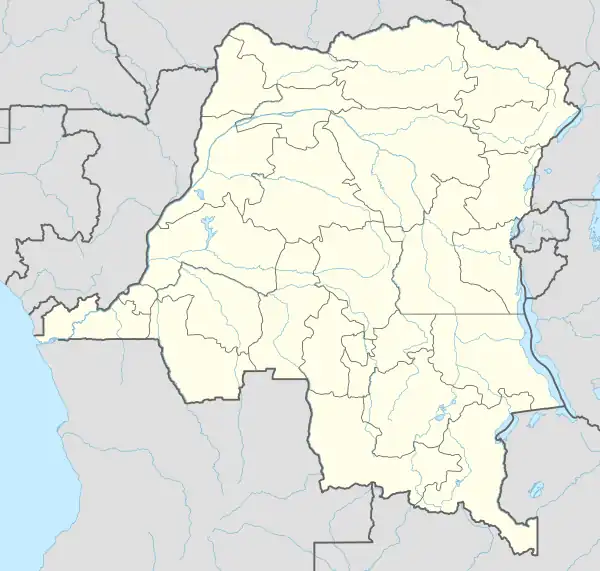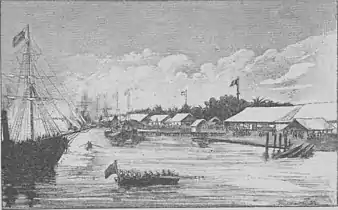Banana, Democratic Republic of the Congo
Banana is a small seaport in the Kongo Central province of the Democratic Republic of the Congo on the Atlantic coast. The port is situated in Banana Creek, an inlet about 1 km wide on the north bank of the Congo River's mouth, separated from the ocean by a spit of land 3 km long and 100 to 400 m wide. The port is located on the creek side of the spit, which shelters it from the ocean. It is about 8 km south-east of Muanda to which it is connected by a paved road running along the coast.
Banana | |
|---|---|
 Banana Location in Democratic Republic of the Congo | |
| Coordinates: 6°1′S 12°25′E | |
| Country | |
| Province | Kongo Central |

Facilities
The port of Banana consists of one wharf of 75 m and depth 5.18 m, with two small cranes for cargo handling, and a few small jetties. The port has an oil terminal 4 km further upriver, to which tankers discharge while at anchor in the creek. The terminal has a quite separate road access east of Muanda. There are no major facilities in Banana apart from the port, since these are provided by the much larger town of Muanda, where the nearest airport is located. There is no rail link.
There is also a naval base of the Navy of the Democratic Republic of the Congo, which is partly maintained with Chinese assistance.[1]
In early 2022, a $1.2 billion construction project began to turn the port into the DRC's first deep-water port.[2] The work is being carried out by DP World, despite a lack of public tender, as part of its 30 year development and management contract.[2][3] When completed in 2025, the port is expected to process over 300,000 containers per year.[2] The project has been criticized for its potential environmental threats, since it borders the country's Mangroves National Park, home to vulnerable and endangered plant and animal species.[2]
Climate
| Climate data for Banana | |||||||||||||
|---|---|---|---|---|---|---|---|---|---|---|---|---|---|
| Month | Jan | Feb | Mar | Apr | May | Jun | Jul | Aug | Sep | Oct | Nov | Dec | Year |
| Average high °C (°F) | 31 (87) |
31 (87) |
31 (88) |
31 (88) |
30 (86) |
27 (81) |
26 (78) |
26 (78) |
27 (80) |
28 (83) |
29 (85) |
30 (86) |
29 (84) |
| Average low °C (°F) | 24 (75) |
24 (75) |
24 (76) |
24 (75) |
23 (73) |
21 (69) |
19 (66) |
19 (66) |
22 (71) |
23 (74) |
24 (75) |
24 (75) |
23 (73) |
| Average precipitation mm (inches) | 28 (1.1) |
170 (6.6) |
150 (6) |
140 (5.5) |
110 (4.2) |
2.5 (0.1) |
2.5 (0.1) |
2.5 (0.1) |
2.5 (0.1) |
10 (0.4) |
94 (3.7) |
69 (2.7) |
770 (30.4) |
| Source: Weatherbase[4] | |||||||||||||

History
The town was developed as a port in the 19th century, largely as part of the slave trade. Henry Morton Stanley arrived at Banana in 1879 at the start of an exploratory expedition funded by Leopold II of Belgium. Following the Conference of Berlin (1884–85) the European powers recognised Léopold's claim to the Congo Basin, and in a ceremony at Banana in 1885 the king announced the establishment of the Congo Free State, headed by himself, beginning the period of European colonization.
The Encyclopædia Britannica Eleventh Edition (1911) article on the folkloric belief in werewolves noted that "The people of Banana are said to change themselves by magical means, composed of human embryos and other ingredients, but in their leopard form they may do no hurt to mankind under pain of retaining for ever the beast shape."[5][6]
Banana was the main Belgian naval base of the Congo until independence in 1960.
Notable people
- Mahomet Thomas Phillips (1876–1943), sculptor and stone mason
References
- Wondo, Jean-Jacques (23 May 2018). Joseph Kabila continues to over-equip his regime militarily for the upcoming political deadlines – JJ Wondo Archived 2018-09-25 at the Wayback Machine. Desc-wondo.
- "Construction of Banana Port begins in Congo". Ships & Ports.
- "DP World to start development of Banana Port in the Democratic Republic of the Congo". The Africa Logistics. 10 May 2021.
- "Weatherbase: Historical Weather for Banana, Republic of Congo". Weatherbase. 2011. Archived from the original on 2016-03-03. Retrieved 2011-11-26. Retrieved on November 24, 2011.
- One or more of the preceding sentences incorporates text from a publication now in the public domain: Thomas, Northcote Whitridge (1911). "Lycanthropy". In Chisholm, Hugh (ed.). Encyclopædia Britannica. Vol. 17 (11th ed.). Cambridge University Press. p. 149.
- What We Know And Can Agree On: Wikipedia At 20; What does the future hold for the internet's most popular "information ecosystem"? Archived 2020-10-20 at the Wayback Machine, Simon Garfield, 20/10/2020
External links
- "Port Information". Archived from the original on 2006-11-04. Retrieved 2015-12-22.
{{cite web}}: CS1 maint: bot: original URL status unknown (link)
